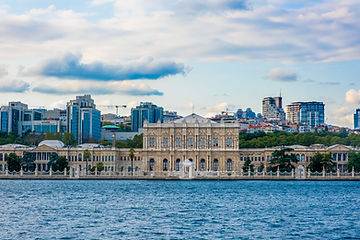
Dolmabahçe Palace
Dolmabahce Palace played a significant role in the transformation of the Ottoman Empire. It became a symbol of the empire's desire to adopt Western values and modernise its administrative structures. The palace's design reflects this shift, with its neoclassical and baroque elements, vast halls, and magnificent crystal chandeliers.
Dolmabahçe Palace Istanbul
Dolmabahçe Palace, commissioned by Sultan Abdülmecid I in the mid-19th century, is an architectural masterpiece that represents the transition of the Ottoman Empire into a more modern era.
Construction of the palace began in 1843 and was completed in 1856. The Sultan desired a new palace that would rival the luxurious residences of European monarchs. Located near the former Beşiktaş Sahil Palace, the new palace was designed by the renowned Armenian Balyan family of architects.
The construction cost of the palace was incredibly high, amounting to five million Ottoman gold lira, equivalent to approximately $1.9 billion in today's gold values. The expenses incurred during the construction put a significant strain on the empire's finances and contributed to its financial troubles in the following years.
Dolmabahçe Palace served as the residence for six Sultans until the abolition of the Caliphate in 1924. It was then transferred to the ownership of the new Turkish Republic, becoming part of the national heritage. Mustafa Kemal Atatürk, the founder and first President of Turkey, used the palace as a summer residence and made important decisions there. He also spent his final days in the palace, passing away in 1938.
Today, Dolmabahçe Palace is managed by the Directorate of National Palaces and is open to the public. Visitors can explore its magnificent halls, admire the opulent interiors, and learn about the history and cultural significance of the palace.
A visit to Dolmabahçe Palace offers a glimpse into the grandeur and splendour of the Ottoman Empire's final years and provides a deeper understanding of Turkey's rich history.
